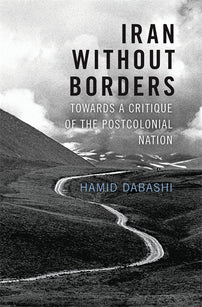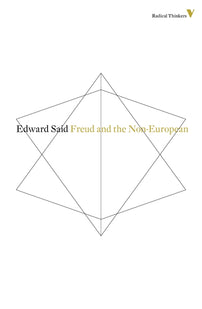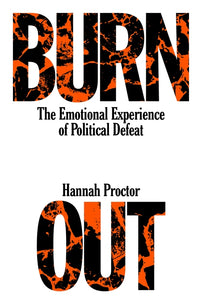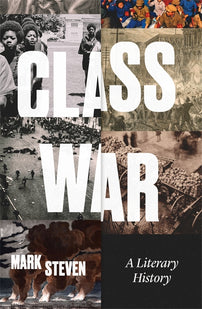The split-subjects of the revolution
Revolutionary publishing has a long history in Iran. Often published anonymously, with blank spaces where the author's name should be, these came to be known as Jeld-sefid, or White-Covers. Here, Samaneh Moafi uncovers their history and there ongoing influence.

Image: Jeld-sefid edition of Frantz Fanon’s The Wretched of the Earthpublished. Translation attributed to Ali Shariʿati. Image: Eskandar Sadeghi-Boroujerdi,
To Qiyām – to revolt – is to stand up.[1] It is to renounce subjugation. And every act of renunciation begins with a split: a regime of suppression, seamless and infinite, reappears as a brittle composition of fractures and boundaries. A people stand up to break through.
Woman, Life, Freedom, the uprising that broke in September 2022 and carried into 2023, was one such event. By the time you read these notes, it will have an extended bibliography: publications have been archived and translated it from the street to paper. The history of revolutionary writing in Iran, however, is not a history of such closures.
What are the kinds of subjectivities that break through? It was with a commitment to these questions in the wake of an uprising in the name of Mahsa (Jhina) Amini, a Kurdish Iranian woman with two names, Kurdish and Iranian, that I began to analyse a particular revolutionary subject: she who finds her renunciation in writing; and chooses to do so without her name.
White-Covers
Many of the Iranian political publications of the 1960s and 70s are held in private archives, often outside the country. The Berlin-based Iran Archive of Documents and Research is one archival space, a rare one that is publicly accessible.[2] Arranged tightly on the shelves of a small room, the hundreds of pamphlets, magazines and books are categorised according to the convictions each adhered to: the publications of Fadaian Khalgh, for example, occupy a separate space to those of Rah-e Kargar, another of the more prominent opposition parties.
Despite the differences in their politics, the publications share a common aesthetic form: there are no elaborate graphics, and professional binding is rare. More often the pages are held together by a few staples. The ink is often smudged on the paper, a photocopy of a photocopy of a photocopy.[3] It feels as though they are designed to last for only a few minutes, no longer than the time they take to read, like a breath, a spoken word; as though they resist the endurance of the archive. These characteristics pertain to a particular form of publication known as Jeld-sefid, or White-Cover.
Revolutionary writing was banned by Iran’s Intelligence Service (Savak) in the 1970s, just as is today. When identified, revolutionary authors were arrested, detained and tortured, physically and psychologically, their families and loved ones becoming subject to systematic state harassment. In this context, White-Cover became a form of political critique. It applied to all genres of writing, from short opinion pieces to political novels, prisoners' memoirs, party literature, analysis, manuals, and information booklets, including most laborious editorial tasks like the translation of the works of Marx and Engels.
Another dimension of White-Cover, one that reaffirmed its meaning, was the absence of the name of the author or translator on the cover. When the work of well-known figures associated with communist groups, such as Khosrow Golsorkhi or Ashraf Dehghan, came to be published, it was the name of the publishing house that was left blank. Each too had a different model of production and distribution. Produced at night, outside of official work hours, and distributed not by bookstores but by makeshift stands and street kiosks, they passed from hand to hand, stored under beds in student dorms.
In form, the name White-Cover related to the shape of publications: the materiality of paper, the ink, the binding and the graphic design of the objects. Just like the anonymisation of the author, the means of production masked their origins, the exact type of printer, the exact origin of the paper or any other design mark that would reveal an identity or place. In principle, they represented a political commitment from writers, publishers and distributors. These subjects had abandoned their own names and trademarks. They had joined each other, in becoming an other to themselves.
Split-Subjects
The history of revolutionary writing in Iran, is also a history of splits. What goes into their making?
Names are means for identification. Through them, an individual can be mapped a particular history. Sometimes, they provide the possibility for writers to build on and take advantage of level of fame or credibility, be it theirs or of their network. The White-Cover required the referent to break from their attributes. It required the occupation of a coordinate without affiliation. The work was to create a position on its own, and from scratch. It was only after being adopted on a regular basis that a pseudonym would provide continuity and coherence amongst an otherwise scattered set of thinking and writing.[4]
[book-strip index="1" style="buy"]
One of the most influential Iranian philosophers of the revolutionary movement of the 1970s, Ali Shariati, adopted a set of pseudonyms, some indicative of the cities he wrote from. When in the religious city of Mashhad, he published his journalistic work under شمع (Sham), which translates as candle. After his move to France in 1958, he adopted a French abbreviation, Chandelle (شاندل).[5] Gradually, each pseudonym came to characterise a unique subject with particular coordinates, distinct from Shariati himself. Following his return to Iran in 1964, he referred to Chandelle as a person he had once been acquainted with: a Tunisian French libertarian poet, writer and orientalist. With time, he had become a composite of subjects, speaking from different and differing coordinates.
It was around this time that Freud’s Outline of Psychoanalysis was first translated into Farsi. In it, Freud write of the splitting of the ego, or Ich-spaltung,[6] which describes “a rift in the ego” which never healed but which increases as time passes.[7] Through this, Freud analyses the way that two contradictory attitudes come to exist in a subject: that of acceptance, and that of disavowal.[8] Within its framework, denying a subject was a way of affirming its existence.
For Freud, split subjects were suffering from psychosis, fetishism and neurosis. Later, Jacques Lacan engaged with the concept to discuss a divide in subordination to the signifier. In his interpretation the subject was split by the very fact that they were a "speaking being." Language, for Lacan, divides the subject who speaks, the unconscious I of the enunciation, from the grammatical I who represents the subject in the statement. The latter designates the enunciated subject, but does not signify them. In other words, the subject can never be in any form other than split, as long as they are a speaking being.[9] It is through what has been repressed within language that the field of the other is marked and the split-subject is determined before them.
[book-strip index="2" style="buy"]
Language, and in turn the determination of the field of the other, and the split subject is a shared act. This aspect was particularly drawn on by a student of Lacan, the French philosopher Paul Ricoeur, who visited Tehran in 1995 and gave a lecture at the Hekmat and Adyan institute, which had just reopened after its closure during the years of the revolution: “Speaking is a collective act, a collective act that entangles one's memory to another’s… we belong to memories, and it is only in speaking that they will be experienced as collective memories.”[10] With this interpretation qiyāms can be understood in the way they break open new conditions for speaking, sensing and sense making, new aesthetic forms and new practices. The signified subjects are urged with the necessity to speak, and confronted with the impossibility of doing so from their position. They renounce their subjugation and break into another. Together, they split.
Woman, Life, Freedom and the Subjects of a Qiyām
A growing number of works delivered by prominent publishers and authors in diaspora speak to Woman, Life, Freedom.[11] Chowra Makaremi’s Femme! Vie! Liberté! (2023) is one: a soft covered book with a sharp graphic design that inscribes the movement’s slogan in shades of red. Her writing operates like an echo-chamber; as if synchronising timelines, she summons her memories of state violence and people’s struggle from previous sequences of history for every day of the autumn of 2022. In practice she comes to translate the movement from the street to the archive, and in doing so brings a kind of a closure. Closure comes after the split, and it is the latter with which my essay is concerned with.
Like other qiyāms of contemporary Iran, the movement in the name of Mahsa (Jhina) Amini was pregnant with revolutionary split-subjects. Another, lesser known example was the anonymous video that circulated in July 2023 of a digital reconstruction of the gate to the University of Tehran.[12] The thin folding concrete form had for years been the subject of 3D modelling assignments for first year architecture students. Here through the work of the model the gate was made to split from its architectural heritage, reappearing as a silent witness to state violence. The model included photographic evidence of military and police violence around the university since the 1953 coup, including the revolutionary years of 1978, the international women's day of 1979, the student protests of July 1999, the One Million Signature Campaign of 2005 and the uprising in the name of Jhina. Arranged spatially in relation to the gate, sometimes shielding its insides, and sometimes occupying the foreground, the photographs function like a speech act, calling upon the gate to speak.
A better known example of writing anonymously was a report from an incident during protests in a small city, by a woman calling herself L.[13] Her note was titled “Women reflected in their own history” and considering the pseudonym she had adopted, she wrote: “While this naming shelters me from the threats of the regime’s forces, it liberates me from my notion of love, especially at a moment when names have become code names.”[14] By then a number of other young women – Nika Shakarami, Sarina Esmailzadeh, Ghazaleh Chalabi, Hananeh Kia and Hadis Najafi – had been killed in the uprising, their names becoming codenames for street action. The protest song Avaz-e Leilaha, or The Voice of Leilas, echoed this,[15] referencing a letter by a Kurdish teacher to his students before his execution: “Remember not to turn your back on poetry, your voices, your Leilas, your dreams.”[16] The Voice of Leilas was the performance of a collective refuge to a code name. To sing the song together, was to recognise and speak to a shared dream.
The renouncing subjects of Woman, Life, Freedom, were the daughters of White-Covers. With the passage of time, the rift between their acceptance and disavowal has not healed, it has only increased. The closure of the movement today, and its translation from the street to the archive is a reality. But closures are not terminations. Qiyāms come as successions, and so do their split-subjects. The rift grows. Iran’s history of revolutionary writing is a history of breaking into new conditions of collective speaking, sensing and sense-making. It is a history of subjects who speak, subjects who call the streets and gates of their cities, the silent witnesses, to speak.
Dr Samaneh Moafi is an academic researcher and architectural investigator. She is the assistant director of research at Forensic Architecture (FA).
[book-strip index="3" style="buy"]
[1] I’m grateful to Omid Montazeri for introducing me to the political history of Qiyams in Iran and much more.
[2] The archive began in 1991 and it was registered in 1992. Since 1999 some of its materials have been digitised. See: https://iranarchiv.de/
[3] Chowra Makaremi provides an interesting reading on the topic of white-covers. In her approach the photocopy machine and the method for reproduction played a significant role in their success. Source: Darabi, H. and Makaremi, C. (2019), Enghelab Street: A Revolution through Books: Iran 1979–1983. P.313-314
[4] In English, the term is a derivation from the greek words ψεῦδος (pseûdos) 'lie, falsehood' and ὄνομα (ónoma) "name" and as such refers to a decisive practice. The Farsi term for pseudonym however, مستعار Mosta’ar leads to the arabic root of (استعارة) Este’areh, which describes ‘borrowing’. Far from falsehood or lie as the Greek root of the word implies, a Mosta’ar name describes a borrowed name, a temporary condition where one would adopt the name of another.
[5] Between 1958 and 1963, Shariati was based in France at and acted as a regular contributor to the Party journals of Jebhe Melli, including Iran-e Azad and Nameh-Parsi. Source: http://drshariati.org/
[6]Freud, S. (1938) "An outline of Psychoanalysis." was translated by Farid Joharkalam
[7] Freud, S. (1940) "Splitting of the Ego in the Process of Defence." SE XXIII p. 276
[8] Ibid. p. 273
[9] Lacan, Jacques. Écrits: A Selection. Trans. Alan Sheridan. London: Tavistock Publications, 1977. p. 269
[10] The Institute was founded in 1975 under the title of the Monarchic Anjoman of Philosophy for the purpose of gathering philosophical thoughts before and after Islam and building an intersection between eastern and western schools of thought. The institute was closed between 1979 and 1983. It operated under various names until 1999 when it was registered as the Institute of Hekman and Philosophy. See: https://www.irip.ac.ir/
The talk was delivered in French. This english translation is based on the transcripts of the Farsi translation. Ricoeur, P (1995), Memory, History and Forgetting. Hekmat and Adyan institute. See: https://ensani.ir/file/download/article/20101103141755-62.pdf
[11] Take for example the following which also happen to share similar titles: Sotoudeh, N (2023), Woman, Life, Freedom, Ithaca: Cornell University Press; Makaremi, C. (2023), Femme! Vie! Liberté!, Paris: La Découverte; Karimi, P. (2024), Woman, Art, Freedom, Leuven: Leuven University Press; Satrapi, M. (2024), Woman, Life, Freedom, New York: Seven Stories Press.
[12] Rendered as a video essay in the form of a short instagram story, the model was published through an independent Syrian media platform. Anonymous (2023), Resistance Gate, Al Jumhuriya. Available here.
[13]The archive of the Iranian feminist platform Harass Watch, holds dozens of reports and reflections from the ground under pseudonyms. L’s essay was amongst them. L (2022), Women reflected in their own history, Harasswatch. Available here.
[14]Soon, her essay was translated to three languages. Like writer L, many of her translators had split from their identities and chosen to remain anonymous. In English: L (2022), Women reflected in their own history, E-flux. Available here.
In Arabic: L (2022), Women reflected in their own history, Megaophone, Available here. In Turkish: Altiyazi Fasikul, here.
[15] Around the time of the Oct 22nd demo in Berlin, this protest song leaked in social media. Available here.
[16] Kamangar, F. (2015) Dad gave water?, Bonyad-e Kamangar. Available here.



